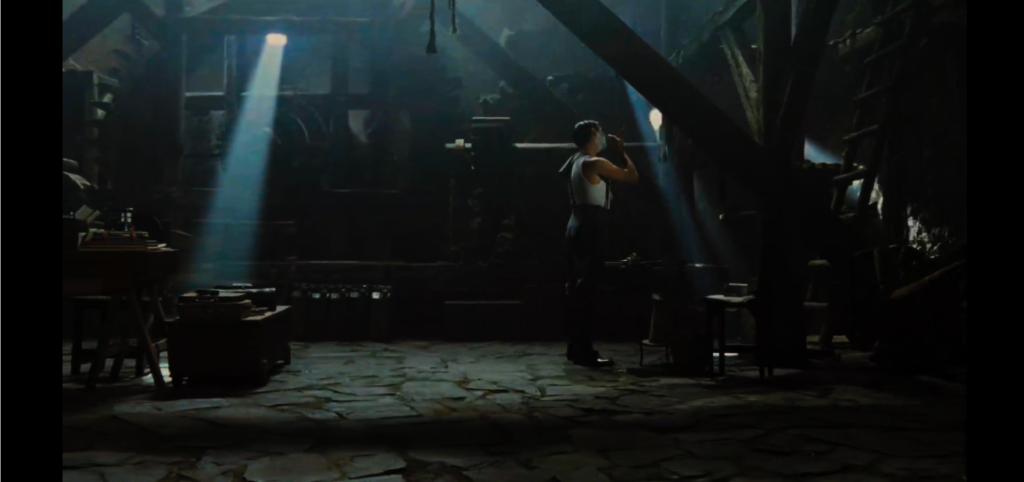POV shot of the main character opening his eyes and looking around
Close up handheld shot of the man looking around whilst the camera is going in an out of focus
Dutch angle shot of the man standing up
Long shot of the man walking around the room and walking towards a phone on the ground.
Close up shot of the phone as it is being picked up
Shoulder shot of him turning it on and seeing the date on the phone
Man 1: how long have I been out
medium shot of the man placing the phone on the ground
close up shot of the phone as it pans to some pills next to a bag
medium shot of man picking up pills
extreme close up shot of the man eating the pills
tracking shoulder shot of the man walking through the house and into another room where he finds a family picture.
Close up shot of the family picture
he picks it up visibly confused
Man 1 : who is this
Man turns around and starts looking unpleasant
Man1 : what’s that noise
Dutch angle of the man turning around and looking confused
Close up shot of him dropping the picture as it smashes
Camera pans to medium close up of a sleeping man on the sofa
Wide shot of the sleeping man and the man on opposite sides of the room
Close up shot of the sleeping mans closed eyes as the audio of the man snoring plays
Close up shot of the man stumbling through the rooms to get back to the door.
Close up of the door knob as the man tries to open it but he cant because it’s locked
Medium shot of the man stumbling back to his bag and taking more of the pills.
Extreme close up of him eating the pills
He blacks out.
Close up shot of the man on the portait
Cuts to a Overhead shot of the Man on the portrait in the living room in bed
Close up shot of his alarm going off
Medium shot of him waking up
Cuts to Tracking shot of him walking to his kitchen
Ellipse cut to a overhead shot of the coffee being made
Wide shot cut to him walking into his living room and sitting in the chair
Close up shot of the door bell being rang
Man 2 : Shouts “come in”
Close up shot of bell being rang again
Man 2: Frustrated ” I said come in”
Extreme close up shot of of the door ringing again
Man 2 gets up up and answers door
Man 2 opens the door and Man 1 is waiting
Man 2: “I said come in you know”
Man 1: “sorry didn’t hear you
Medium shot of man 1 entering the house
Man 2” you must be here for the plumbing
Man 1″ yeah that’s right”
Tracking shoulder shot of Man 1 and Man 2 walking through the house onto the kitchen.
Man 2″ do you prefer tea or coffee
Man 1″coffee please”
Wide shot of the room as man 2 is pouring coffee
Man 2″ I’m going to go toilet real quick just bring the coffees into the living room when you’ve made them
Man 1″ Sure thing”
Medium shot of Man 2 leaving room,
Shot pans to man 1 grabbing some powder from his bag
Close up shot of the man pouring the powder into one of the coffees.
Tracking shot of him brining the coffees to the man in the living room
Man 2″cheers mate”
Man 1″no problem”
Man 1 and Man 2 take a sip of their coffee
Man 2″this is strong”
Man 2 passes out on the chair
Man 1 takes both coffees back to the kitchen and opens his bag
He begins stealing items from the owner like ornaments and emptying them into his bag
Extreme close up shot of the pills.
He moves some pills in his bag so he can put some more stuff in their
He appears to be tired so takes a sip of the coffee
Extreme close up shot of his eyes drowsily shutting.
Dutch shot of him falling on the ground.
Quick cut to a wide shot of the sleeping man and man 1
Tracking shot of man 1 walking into the other room
Dutch angle shot of him clutching his head and looking shocked
He the collapses to the floor and drops his bag
Zooming out shot of the mans unconscious body
Cut to man 1 acting shocked after realising what he’s done
Tracking shot of him walking out the room
POV shot of him placing his hand on the door
Audio of police siren plays
Movie cuts to black.


















